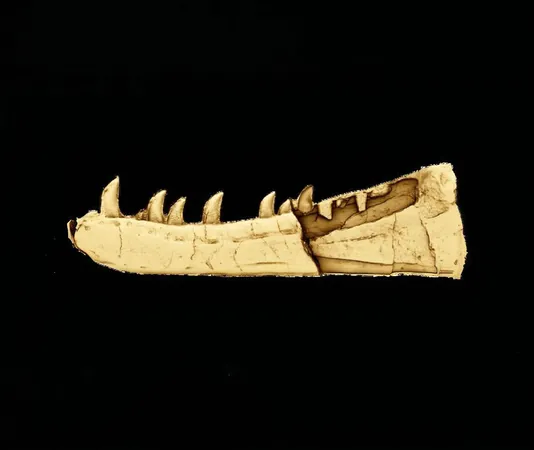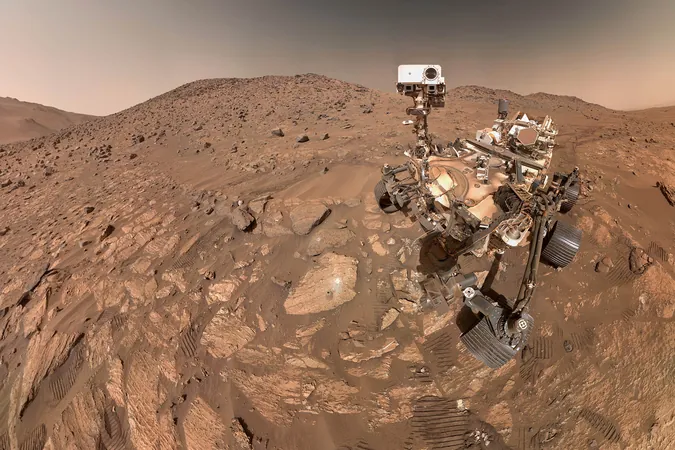
Unveiling Newtonsaurus: The Giant Triassic Predator That Was Forgotten for a Century
2025-09-15
Author: Liam
Prepare to be amazed! A jaw-dropping discovery has emerged from the dusty archives of the National Museum of Wales, where a fossil jawbone has finally been identified over a century after it was first collected in 1899.
A Forgotten Fossil Resurfaces
The fossil sat in obscurity for more than 100 years, sparking curiosity but evading classification. Thanks to advanced technology, paleontologists at the University of Bristol have now unveiled its true identity: a brand-new dinosaur species called Newtonsaurus, named in honor of the original discoverer.
Modern Magic: From Mold to Model
At first glance, this fossil may seem disappointing—composed entirely of natural molds without any bone remaining. However, these molds captured intricate details that lie invisible to the naked eye. By employing cutting-edge 3D scanning techniques, researchers digitally resurrected the jawbone.
"We employed photogrammetry to meticulously photograph the fossil from every angle, creating a stunningly detailed digital model," explained co-author Owain Evans. This reincarnation allows us to see grooves, ridges, teeth, and even serrations that were once obscured.
A Fierce Carnivore
Upon analysis, the distinctive features clearly indicated that Newtonsaurus was a theropod—a carnivorous dinosaur that thrived during the Triassic period. This exciting discovery suggests that the Welsh coastline was once home to large predatory dinosaurs, shedding new light on the region's prehistoric ecosystem.
"Evidence suggests this specimen belonged to a sizeable predatory theropod, potentially as long as 7 meters (23 feet) when fully fleshed out," said Evans. This makes it a giant relative to other theropods of that time, which were typically much smaller.
A Game-Changer for Welsh Paleontology
This significant find not only enriches the prehistoric record of Wales but also underscores the hidden treasures that museum collections can hold. As Cindy Howells from the National Museum of Wales pointed out, such historical specimens can yield vital insights, even after years of being overlooked.
"The re-description of Newtonsaurus serves as a powerful reminder of Wales' ongoing importance in the world of paleontological research," she added.
What's Next for Wales?
Though Triassic beds are scarce globally, Wales possesses several sites with the potential to uncover even more ancient secrets. Newtonsaurus exemplifies how even long-forgotten fossils can yield remarkable surprises and highlights the fact that modern technology can finally answer questions that have puzzled scientists for decades.
Could Wales still be hiding more prehistoric giants? Only time will tell as paleontologists continue to dig deeper into this fascinating chapter of Earth's history.
Final Thoughts
This incredible discovery of Newtonsaurus not only expands our understanding of Triassic fauna but also ignites excitement about what other wonders may be lurking within the cliffs and quarries of Wales. Stay tuned, because the story of our planet's ancient past is far from complete!









 Brasil (PT)
Brasil (PT)
 Canada (EN)
Canada (EN)
 Chile (ES)
Chile (ES)
 Česko (CS)
Česko (CS)
 대한민국 (KO)
대한민국 (KO)
 España (ES)
España (ES)
 France (FR)
France (FR)
 Hong Kong (EN)
Hong Kong (EN)
 Italia (IT)
Italia (IT)
 日本 (JA)
日本 (JA)
 Magyarország (HU)
Magyarország (HU)
 Norge (NO)
Norge (NO)
 Polska (PL)
Polska (PL)
 Schweiz (DE)
Schweiz (DE)
 Singapore (EN)
Singapore (EN)
 Sverige (SV)
Sverige (SV)
 Suomi (FI)
Suomi (FI)
 Türkiye (TR)
Türkiye (TR)
 الإمارات العربية المتحدة (AR)
الإمارات العربية المتحدة (AR)